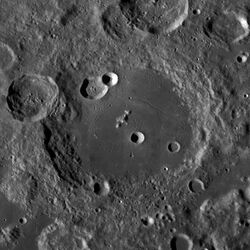Astronomy:Cleomedes (crater)
 LRO mosaic | |
| Diameter | 126 km |
|---|---|
| Depth | 2.7 km |
| Colongitude | 304° at sunrise |

Cleomedes is a prominent lunar impact crater located in the northeast part of the visible Moon, to the north of Mare Crisium. It was named after Greek astronomer Cleomedes.[1] It is surrounded by rough ground with multiple crater impacts. The irregular crater Tralles intrudes into the northwest rim. To the east is Delmotte. North of Cleomedes is a triple-crater formation with Burckhardt occupying the center.
The outer wall of Cleomedes is heavily worn and eroded, especially along the southern part of the wall. Cleomedes C lies across the south-southwest rim. The crater floor is nearly flat, with a small central peak to the north of the midpoint, forming a linear ridge toward the north-northeast. There are several notable craterlets on the floor, including a pair of overlapping craters just inside the northwest rim.
A rille named Rima Cleomedes crosses the northern floor, running southeast from the northwest rim. This rille branches in a fork after crossing the crater mid-line. Smaller clefts lie in the southeast part of the floor.
Cleomedes is one of the largest craters of Nectarian age.[2]
Satellite craters
By convention, these features are identified on lunar maps by placing the letter on the side of the crater midpoint that is closest to Cleomedes.
| Cleomedes | Latitude | Longitude | Diameter |
|---|---|---|---|
| A | 28.9° N | 55.0° E | 12 km |
| B | 27.2° N | 55.9° E | 11 km |
| C | 25.7° N | 54.9° E | 14 km |
| D | 29.3° N | 61.9° E | 25 km |
| E | 28.6° N | 54.4° E | 21 km |
| F | 22.6° N | 56.9° E | 12 km |
| G | 24.0° N | 57.3° E | 20 km |
| H | 22.4° N | 57.6° E | 6 km |
| J | 26.9° N | 56.8° E | 10 km |
| L | 23.8° N | 54.4° E | 7 km |
| M | 24.2° N | 51.6° E | 6 km |
| N | 24.8° N | 52.5° E | 6 km |
| P | 24.8° N | 56.4° E | 9 km |
| Q | 24.9° N | 56.9° E | 4 km |
| R | 29.5° N | 60.2° E | 15 km |
| S | 29.5° N | 59.0° E | 8 km |
| T | 25.8° N | 57.7° E | 11 km |
References
- ↑ "Cleomedes (crater)". Gazetteer of Planetary Nomenclature. USGS Astrogeology Research Program.
- ↑ The geologic history of the Moon. USGS Professional Paper 1348. By Don E. Wilhelms, John F. McCauley, and Newell J. Trask. U.S. Government Printing Office, Washington: 1987. Table 9-4.
- Andersson, L. E.; Whitaker, E. A. (1982). NASA Catalogue of Lunar Nomenclature. NASA RP-1097.
- Bussey, B.; Spudis, P. (2004). The Clementine Atlas of the Moon. New York: Cambridge University Press. ISBN 978-0-521-81528-4.
- Cocks, Elijah E.; Cocks, Josiah C. (1995). Who's Who on the Moon: A Biographical Dictionary of Lunar Nomenclature. Tudor Publishers. ISBN 978-0-936389-27-1. https://archive.org/details/isbn_9780936389271.
- McDowell, Jonathan (July 15, 2007). "Lunar Nomenclature". Jonathan's Space Report. http://host.planet4589.org/astro/lunar/.
- Menzel, D. H.; Minnaert, M.; Levin, B.; Dollfus, A.; Bell, B. (1971). "Report on Lunar Nomenclature by the Working Group of Commission 17 of the IAU". Space Science Reviews 12 (2): 136–186. doi:10.1007/BF00171763. Bibcode: 1971SSRv...12..136M.
- Moore, Patrick (2001). On the Moon. Sterling Publishing Co.. ISBN 978-0-304-35469-6. https://archive.org/details/patrickmooreonmo00patr.
- Price, Fred W. (1988). The Moon Observer's Handbook. Cambridge University Press. ISBN 978-0-521-33500-3.
- Rükl, Antonín (1990). Atlas of the Moon. Kalmbach Books. ISBN 978-0-913135-17-4.
- Webb, Rev. T. W. (1962). Celestial Objects for Common Telescopes (6th revised ed.). Dover. ISBN 978-0-486-20917-3. https://archive.org/details/celestialobjects00webb.
- Whitaker, Ewen A. (1999). Mapping and Naming the Moon. Cambridge University Press. ISBN 978-0-521-62248-6.
- Wlasuk, Peter T. (2000). Observing the Moon. Springer. ISBN 978-1-85233-193-1.
External links
- High resolution lunar overflight video by Seán Doran, based on LRO data, that passes over Mare Crisium and ends over Cleomedes (see album for more)
 |


